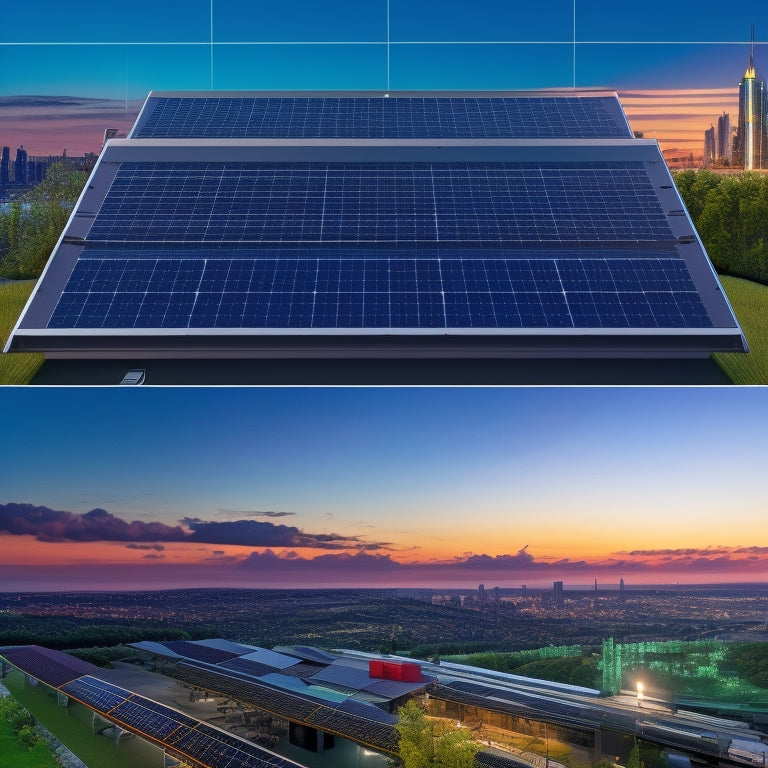
Tracking Commercial Solar Panel Output for Maximum ROI
Share
By leveraging real-time data tracking and analysis, you can optimize your commercial solar panel output to maximize returns on investment (ROI) by identifying areas of energy waste, predicting potential issues, and making data-driven decisions to improve system performance. Familiarity with performance metrics, such as energy yield assessment and efficiency rates, is vital for peak output. Real-time tracking provides instant alerts for performance deviations, enabling swift action, and predictive analytics identify potential problems before they occur. As you investigate the world of commercial solar panel tracking, you'll uncover more opportunities to streamline your system and enhance its ROI potential.
Key Takeaways
- Real-time tracking of solar panel output enables swift action on performance deviations, reducing downtime and increasing ROI.
- Analyzing energy consumption patterns and seasonal trends helps optimize energy production, reduce waste, and maximize ROI.
- Predictive analytics and benchmarking against industry standards facilitate proactive maintenance, reducing costs and extending equipment lifespan.
- Identifying energy efficiency opportunities through data analysis and energy audits helps minimize waste and optimize solar panel output.
- Optimizing system design and layout through adjusting panel angles, shading analysis, and energy storage integration further increases energy production potential.
Understanding Solar Panel Performance
Get familiar with your solar panel's performance metrics to enhance its energy output. You need to track key efficiency metrics, such as energy yield assessment, to guarantee your system is running at peak performance.
Over time, performance degradation is inevitable, but understanding the rate of degradation helps you plan for maintenance and replacement within the solar panel lifespan.
To maximize energy output, you must consider environmental impact, grid integration, and system reliability. Technology advancements have improved efficiency, but it's vital to follow installation best practices to secure optimal performance.
A cost-benefit analysis will help you weigh the expenses of maintenance against the benefits of optimal energy production.
Choosing the Right Monitoring System
You've invested in a solar panel system, and now it's important to track its performance to guarantee maximum energy output. Choosing the right monitoring system is essential to ascertain you're getting the most out of your investment.
When selecting a monitoring system, consider the following key features:
-
Cloud-based solutions with user-friendly interfaces that provide easy access to your system's performance data.
-
Installation costs and system compatibility to guarantee a seamless integration with your existing infrastructure.
-
Data accuracy and historical data storage to identify trends and optimize your system's performance over time.
Additionally, look for a system that offers mobile accessibility, alert notifications, and scalability options to future-proof your investment.
Customer support is also significant in case you encounter any issues or have questions about your system's performance.
Benefits of Real-Time Data Tracking
Most solar panel systems produce a substantial amount of data, but it's the real-time tracking of this data that reveals the full potential of your investment. With real-time data tracking, you'll receive instant alerts when your system's performance deviates from expected levels, allowing you to take swift action to rectify any issues.
Predictive analytics also enable you to identify potential problems before they occur, reducing downtime and increasing overall efficiency.
Real-time data tracking enhances user engagement by providing a clear, concise depiction of your system's performance through intuitive data visualization. This enables you to compare your system's performance to industry benchmarks, identifying areas for improvement and opportunities for cost savings.
Integration capabilities with existing systems and cloud storage guarantee seamless data management, while mobile accessibility allows you to monitor your system's performance from anywhere.
Identifying Energy Efficiency Opportunities
By analyzing real-time data from your solar panel system, you can pinpoint areas where energy is being wasted and identify opportunities to optimize your system's performance. This granular understanding enables you to conduct energy audits, pinpointing inefficiencies and areas for improvement.
-
Inefficient building upgrades: Identify opportunities to upgrade building insulation, windows, and HVAC systems to reduce energy consumption and optimize your solar panel output.
-
Inefficient operational strategies: Analyze your operational strategies, such as scheduling and resource allocation, to identify areas where energy is being wasted and implement changes to reduce consumption.
-
Inefficient technology integration: Identify opportunities to integrate new technologies, such as energy storage systems, to optimize your solar panel output and reduce energy waste.
Optimizing System Design and Layout
You'll want to optimize your system design and layout to maximize energy output. This involves fine-tuning panel angles to match your site's specific solar irradiance patterns, ensuring that each panel is positioned for peak energy harvesting.
Panel Angle Optimization
As solar panels' energy harvesting capabilities are directly tied to their exposure to sunlight, enhancing their angle becomes a critical factor in maximizing system output.
By adjusting the panel angle, you can increase energy production, reduce energy losses, and ultimately elevate your ROI.
To visualize the impact of panel angle enhancement, consider the following scenarios:
-
Summer morning: Panels tilted at 30° to capture the sun's rays at a shallow angle, maximizing energy production during peak hours.
-
Winter afternoon: Panels tilted at 60° to compensate for the lower sun angle, ensuring superior energy harvesting during shorter days.
-
Year-round: Panels adjusted seasonally to account for the changing sun angle, maintaining peak performance throughout the year.
Shading Analysis Strategies
Enhancing your solar panel system's design and layout is crucial for maximizing energy production, and shading analysis plays a key role in this process. Shading can greatly impact your system's energy output, so it is important to identify potential shading issues and mitigate them.
To conduct a thorough shading analysis, you'll want to use specialized shading tools that can simulate shading patterns and predict their effects on your system's performance. These tools can help you identify areas where shading mitigation strategies can be employed to minimize shading impact.
| Shading Analysis Strategy | Description |
|---|---|
| Shading Simulation | Uses 3D modeling to predict shading patterns and their impact on energy production |
| Shading Optimization | Identifies best panel placement and layout to minimize shading effects |
| Shading Mitigation | Implements strategies to reduce shading impact, such as pruning trees or installing skylights |
Maximizing Energy Production Potential
To maximize energy production potential, it's essential to monitor and analyze your solar panel system's performance regularly. This involves tracking key performance indicators (KPIs) such as energy output, inverter efficiency, and grid connectivity. By doing so, you can identify areas of improvement and optimize your system for maximum ROI.
Here are three significant factors to take into account:
-
Solar panel degradation: Monitor your system's energy output over time to detect any signs of degradation, which can impact your overall energy production potential.
-
Energy storage integration: Verify that your energy storage system is properly integrated with your solar panel system to maximize energy production and reduce grid connectivity challenges.
-
Geographic location impact: Reflect on the impact of your geographic location on your system's energy production potential, including weather variability effects and module technology advancements.
Analyzing Energy Consumption Patterns
You'll want to examine your daily energy usage profiles to understand how your consumption habits vary throughout the day.
By analyzing your energy usage at different times of day, you can identify patterns and opportunities to optimize your energy production.
Additionally, seasonal consumption trends will help you anticipate and prepare for changes in your energy needs over time.
Daily Energy Usage Profiles
Each day, your solar panel system generates a unique energy output profile, influenced by various factors such as weather patterns, seasonality, and your household's energy consumption habits.
Understanding these daily energy usage profiles is vital to maximize your ROI.
Here are three key aspects to reflect on:
-
Peak usage: Identify the time periods when your energy consumption is highest, and adjust your usage patterns accordingly.
-
Off-peak savings: Take advantage of lower utility rates during off-peak hours to reduce your energy costs.
-
Load shifting: Shift non-essential loads to off-peak hours to reduce peak demand and optimize your energy usage.
Time of Day Analysis
Your daily energy usage profiles also reveal useful perceptions when analyzed by time of day. This granular analysis uncovers patterns in energy consumption, helping you optimize your commercial solar panel output.
You'll identify peak usage periods, which often coincide with high sunlight intensity, and adjust your energy storage strategies accordingly. By examining time-of-day data, you'll understand how weather impact, inverter efficiency, and grid interaction influence your energy output. Geographic variation and installation angle also come into play, as do performance benchmarks and consumption forecasting.
Moreover, time-of-day analysis helps you detect potential issues, such as panel degradation, which can negatively impact your ROI. By pinpointing these areas, you can schedule maintenance and optimize your system's performance.
This level of detail enables data-driven decision-making, allowing you to refine your energy strategy and maximize returns. With accurate time-of-day analysis, you'll be well-equipped to maneuver through the intricacies of commercial solar panel output and make informed decisions to drive your business forward.
Seasonal Consumption Trends
Three key periods - winter, summer, and the shoulder months - dominate seasonal consumption trends, with distinct energy usage patterns emerging during each.
Understanding these patterns is vital for optimizing your commercial solar panel output and maximizing ROI.
To visualize these patterns, consider the following:
- Winter: Peak energy consumption occurs during the winter months, driven by increased heating demands and reduced daylight hours, which reduce peak sunlight availability.
This period sees the highest energy storage demands.
- Summer: Energy consumption dips during the summer months, as temperatures rise and daylight hours increase, reducing the need for artificial lighting and heating.
However, this period is ideal for energy harvesting, with peak sunlight hours available for your solar panels.
- Shoulder Months: The shoulder months, typically spring and fall, exhibit moderate energy consumption patterns, with mild temperatures and moderate daylight hours.
These periods require seasonal adjustments to optimize energy production and storage.
Data-Driven Maintenance and Repair
By analyzing solar panel performance data, you can identify potential issues before they cause significant energy losses, facilitating proactive maintenance and repair strategies that minimize downtime and maximize ROI.
This data-driven approach allows you to utilize predictive analytics to detect faults, schedule maintenance, and prioritize repairs. By benchmarking your system's performance against industry standards, you can identify areas for improvement and optimize energy output.
Sensor technology and data visualization tools provide real-time observations into your system's operation, facilitating swift response to system alerts and fault detection.
Cost analysis helps you allocate resources efficiently, while maintenance scheduling guarantees that repairs are completed during periods of low energy demand.
By extending equipment lifespan through proactive maintenance, you can reduce costs and enhance ROI.
With data-driven maintenance and repair, you can verify your solar panel system operates at peak performance, maximizing energy output and minimizing losses.
Frequently Asked Questions
Can I Integrate My Monitoring System With Existing Energy Management Software?
You can integrate your monitoring system with existing energy management software, ensuring seamless data integration, by checking software compatibility and API protocols, which enables you to combine performance data for optimized energy management and informed decision-making.
How Often Should I Calibrate My Monitoring System for Accuracy?
You're fine-tuning a precision machine, ensuring every gear clicks perfectly. To maintain high-quality monitoring accuracy, you should calibrate your system quarterly, like clockwork, to guarantee reliable data and optimize your energy management strategy.
Are There Any Cybersecurity Risks Associated With Real-Time Data Tracking?
When you collect real-time data, you're exposing your system to potential cybersecurity risks that can compromise data integrity; be aware of system vulnerabilities, such as unauthorized access, data tampering, and malware, to guarantee the security of your tracking system.
Can I Use Monitoring Data to Justify Incentives or Tax Credits?
You can utilize monitoring data to justify incentives or tax credits, like Amazon did in 2019, using performance metrics to secure a 30% federal tax credit for their Virginia solar farm, effectively validating incentive claims with hard data.
What Is the Typical ROI for Investing in a Commercial Solar Monitoring System?
When evaluating an investment in a commercial solar monitoring system, you'll want to crunch numbers in your investment analysis, focusing on performance metrics like energy production, consumption, and cost savings to determine a typical ROI of around 10-15%, depending on system size and location.
Conclusion
By tracking your commercial solar panel output in real-time, you'll be able to separate the wheat from the chaff, identifying areas of inefficiency and optimizing your system for maximum ROI. With data-driven information, you'll be enabled to make informed decisions, fine-tune your system's performance, and squeeze every last drop of energy from your investment. By staying on top of your solar panel's output, you'll be well on your way to maximizing your energy production potential and reaping the financial rewards.
Related Posts
-

Long-Term Cost Savings With Solar Panels
Investing in solar panels offers substantial long-term savings on energy costs. You'll benefit from federal tax credi...
-

Solar Energy Efficiency Improvements for Businesses
Improving solar energy efficiency for your business can lead to considerable cost savings and enhance your sustainabi...
-

Solar Energy Grants and Incentives for Homeowners
Maneuvering solar energy grants and incentives is essential for reducing your installation costs. You can benefit fro...


